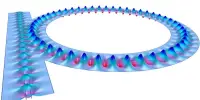Poisson’s Ratio ν(nu) is a measure of the Poisson effect, and it is the ratio of transverse strain to corresponding axial strain on a material stressed along one axis. For a rock core subjected to an axial load, Poisson’s ratio (ν) can be expressed in the following:
ν = εl/ εa
Where εl and εa are the lateral and axial strains, respectively.
Actually, Poisson’s ratio is “the ratio of transverse contraction strain to longitudinal extension strain in the direction of the stretching force.”
The value of Poisson’s ratio is the negative of the ratio of transverse strain to axial strain. For small values of these changes, ν is the amount of transversal expansion divided by the amount of axial compression. Most materials have Poisson’s ratio values ranging between 0.0 and 0.5. Incompressible materials such as rubber have a ratio near 0.5. The ratio is named after the French mathematician and physicist Siméon Poisson.
Poisson’s ratio measures the deformation in the material in a direction perpendicular to the direction of the applied force. Essentially Poisson’s ratio is one measure of a rock’s strength that is another critical rock property related to closure stress. Poisson’s ratio is dimensionless and ranges between 0.1 and 0.45. Low Poisson’s ratio, such as 0.1–0.25, means rocks fracture easier whereas high Poisson’s ratio, such as 0.35–0.45, indicates the rocks are harder to fracture. Please note that Poisson’s ratio changes from layer to layer. The best formations to hydraulically fracture have the lowest Poisson’s ratios. Poisson’s ratio can be measured from a core sample. A core sample is taken to the lab and a compressive force is applied.
When a material is stretched in one direction, it tends to compress in the direction perpendicular to that of force application and vice versa. The measure of this phenomenon is given in terms of Poisson’s ratio. For example, a rubber band tends to become thinner when stretched.
Applications of Poisson’s effect –
One area in which Poisson’s effect has a considerable influence is in pressurized pipe flow. When the air or liquid inside a pipe is highly pressurized it exerts a uniform force on the inside of the pipe, resulting in hoop stress within the pipe material. Due to Poisson’s effect, this hoop stress will cause the pipe to increase in diameter and slightly decrease in length. The decrease in length, in particular, can have a noticeable effect upon the pipe joints, as the effect will accumulate for each section of pipe joined in series. A restrained joint may be pulled apart or otherwise prone to failure.
Another area of application for Poisson’s effect is in the realm of structural geology. Rocks, like most materials, are subject to Poisson’s effect while under stress. In a geological timescale, excessive erosion or sedimentation of Earth’s crust can either create or remove large vertical stresses upon the underlying rock. This rock will expand or contract in the vertical direction as a direct result of the applied stress, and it will also deform in the horizontal direction as a result of Poisson’s effect. This change in strain in the horizontal direction can affect or form joints and dormant stresses in the rock.
Although cork was historically chosen to seal wine bottle for other reasons (including its inert nature, impermeability, flexibility, sealing ability, and resilience), cork’s Poisson’s ratio of zero provides another advantage. As the cork is inserted into the bottle, the upper part which is not yet inserted does not expand in diameter as it is compressed axially. The force needed to insert a cork into a bottle arises only from the friction between the cork and the bottle due to the radial compression of the cork. If the stopper were made of rubber, for example, (with a Poisson’s ratio of about 1/2), there would be a relatively large additional force required to overcome the radial expansion of the upper part of the rubber stopper.
Most car mechanics are aware that it is hard to pull a rubber hose (e.g. a coolant hose) off a metal pipe stub, as the tension of pulling causes the diameter of the hose to shrink, gripping the stub tightly. Hoses can more easily be pushed off stubs instead of using a wide flat blade.
Information Sources:
















